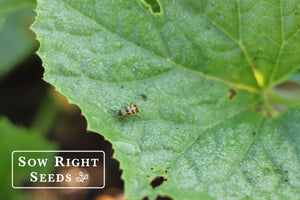Growing Black-Eyed Susan (Rudbeckia hirta) for a Glowing Fall Garden
RudbeckiaIn the heat of summer, when your spring flowers are done blooming, Black-Eyed Susan or Rudbeckia hirta is unfurling golden petals, spreading even more sunshine and attracting pollinators to your garden. The colors of Black-eyed Susan are perfect for summer and fall gardens. It also makes an excellent cut flower with a long vase life. Learn more about growing black-eyed Susan from seed.

There are many varieties of Rudbeckia. Black-Eyed Susan (Rudbeckia hirta) is an extremely popular heirloom variety. This perennial wildflower native to North America has bright yellow petals surrounding a dark brown domed center (a look similar to coneflowers). Black-eyed Susan blooms prolifically in the second year after planting. It also readily self-sows and attracts pollinators.
I’ve noticed that even though they die back in winter, Black-eyed Susans come back bigger and bolder the next year. By July, the rudbeckias will be attracting butterflies and goldfinches.

How to Grow Black-Eyed Susan from Seed
This perennial wildflower is perfect for growing from seed. With this helpful growing information and simple seed germination tips, you’ll enjoy bright Rudbeckia hirta flowers year after year.
Start Black-eyed Susan seeds indoors six to eight weeks before the last frost or sow directly outside in prepared soil. Light is required for germination; firmly press into the growing medium to allow good soil-to-seed contact. Transplant outdoors when seedlings reach 6”.
Another option is to start seeds in July or August. You won’t get many flowers the first year, but the next year, you’ll have a vigorous plant full of flowers.
Winter sowing is another way to start your Black-eyed Susan seeds. This way, you will have seedlings ready for transplanting without the hardening-off phase.
Tips for fail-proof Black-Eyed Susan seed germination
There are several ways to sow Black-eyed Susan seeds. Indoor seed starting gives you control over water, light, and temperature.
Use a seed starting mix.
Gently press seeds onto the moist growing medium.
The planting depth for seeds is 1/16”
Black-eyed Susan seeds require light for germination. So be careful not to bury them.
Place grow lights 2 to 3 inches above the seeds.
Mist the seeds with water.
Use a humidity dome or cover to help keep moisture in and prevent the seeds from drying out.
The optimal soil temperature for germination is 70ºF.
Seeds should start sprouting in 1 to 3 weeks.
Once the seeds sprout and start sending down roots, water the seedlings from the bottom to avoid damping off.

Transplanting Black-Eyed Susan Seedlings
Once the seedlings are 6 inches high and have at least two true leaves, you can start the transplanting process.
First, start by hardening off your seedlings. Even though these will eventually be hardy perennials, the tender seedlings can’t go straight from the protective indoor environment to the outdoor garden. Also, you want to be past all chance of frost, and the ground should be 70ºF.
Start with just an hour on the first day when taking them outside. Place them in a sheltered spot where they won’t get too much wind or sun.
Increase the amount of time outdoors each day. When the Rudbeckia seedlings are ready for outdoor life, transplant them in the evening. This gives them time to adjust before the hottest part of the day.
Space Black-eyed Susan plants 12 to 18 inches apart.

Black-Eyed Susan Plant Care
Sun
Full sun will give you the most amount of Black-eyed Susan blooms. This sun-loving plant can also bloom in dappled shade. But too much shade will result in fewer flowers.
Soil
Black-eyed Susan plants can thrive in all kinds of soil. As heirloom wildflowers, they are used to the natural growing conditions of the prairie. Black-eyed Susans are the perfect flower to grow in clay soil.
Water
Mature Black-eyed Susan plants are drought-resistant. However, when growing from seed or transplanting seedlings, keep the soil moist but not waterlogged. Once the plants have a vigorous root system, give them sufficient water without allowing the soil to stay soggy.
Fertilizer
There’s no reason to add additional fertilizer to these low-maintenance flowers.
Deadheading
You don’t have to deadhead Black-eyed Susans. They are prolific bloomers when grown in full sun. But you can cut flowers to enjoy indoors. They are also excellent at self-sowing, so you can cut off flowers before they drop their seeds to prevent them from dropping.
Winter Care
As winter approaches, you can let the flower heads go to seed. This will give you more plants in the spring. It will also provide food for the goldfinches. Black-eyed Susans are very cold-tolerant and can survive below-freezing temperatures. Black-eyed Susans need vernalization. This is a cold period that tells them to establish strong roots. Adding a thick layer of mulch can help keep the roots from freezing and thawing over winter. Black-eyed Susan plants can be divided in early spring before they start growing or in the fall when they’ve finished blooming.
Black-eyed Susan Companion Flowers
When grown in masses, Black-eyed Susans make an eye-catching display. They are also beautiful when mixed in with other wildflowers.
Yarrow - Yarrow is a perennial with a nice contrast in shape and several colors to choose from. Its easy-growing habit makes it the perfect companion flower.
Shasta Daisy - For a similar look but contrast in color, plant Shasta daisies with Black-eyed Susans.
Zinnias - For a reliable bloomer, plant zinnis with your Black-eyed Susans. They can also be used as cut flowers together in bouquets.
Purple coneflowers - Echinacea or Purple coneflowers have similar low-maintenance growing requirements as Black-eyed Susans and make a nice color contrast.
Sunflowers - There are a range of colorful sunflowers that will grow well and can be used in flower arrangements along with Black-eyed Susans.
Bee balm - Bergamot or Bee Balm is a natural companion flower to Black-eyed Susan. They both thrive in sunny prairie locations.
Solutions to Pests and Diseases
Wildflowers like Black-eyed Susans are naturally somewhat pest and disease-resistant.
Aphids will find their way into everything. Spray them off and use other natural methods to get rid of them.
If plants have consistently wet leaves, they can get powdery mildew. Space plants far enough apart to allow for good airflow and avoid overhead watering.
Deer and rabbits tend to leave Black-eyed Susans alone.
Black-eyed Susan FAQs
Are Black-eyed Susans the same as Brown-eyed Susans?
Both Black-eyed and Brown-eyed Susans are Rudbeckias, and they are very similar but technically different. Black-eyed Susans are Rudbeckia hirta, and Brown-eyed Susans are Rudbeckia triloba. Their petals are also shaped differently.
Do Black-eyed Susans spread?
Black-eyed Susans are great at self-sowing and will also continue spreading through their roots over the years.
Is Black-eyed Susan a perennial?
Black-eyed Susan (Rudbeckia hirta) is a hardy perennial that can withstand both drought and freezing temperatures.
Black-eyed Susans, or Rudbeckia hirta, are beautiful perennials that you’ll love. They are very low maintenance, thrive in all kinds of soil, and are drought and deer-resistant. The stunning bright yellow petals with brown to black centers will glow in your garden from July to winter.
Written by Beverly Laudie




Just a comment…here in Wisconsin, Black eyes Susan’s are NOT deer resistant!!!
Leave a comment